Suunto vs Garmin: Fenix 6 vs Suunto 9 GPS Running Watch Comparison
Last Updated: January 22, 2024 Author: Jake Thompson
In my quest for the perfect adventure companion, I've weighed the precision of Garmin against the durability of Suunto, and the intuitiveness of Suunto's interface against Garmin's extensive feature set. As a professional writer interested in the latest tech, I understand that choosing between these two can be as challenging as summiting a peak or completing a triathlon. My experiences with both brands have led me to appreciate the subtle yet significant differences that could tip the scales for potential buyers.
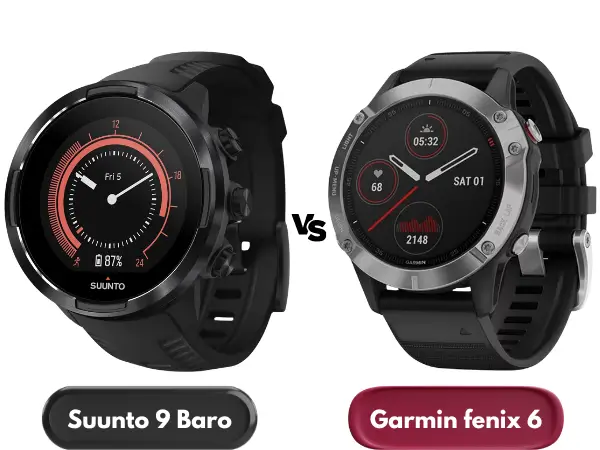
In the following sections, I'll unpack these distinctions, offer a balanced viewpoint on their ecosystems, and compare their performances in real-world scenarios. Whether you're gearing up for your next race or simply curious about which brand could best support your active lifestyle, I invite you to explore this comparison, which just might influence your next big purchase.
Table of Contents:
- Key Takeaways
- Table: Garmin vs Suunto GPS Watch Comparison
- Pros & Cons
- Brand Comparison
- Assessing Build Quality
- Battery Life
- Wearability
- Design
- Comfort
- Smartwatch Capabilities
- Sensor Accuracy and Performance
- Software and Customization
- Final Verdict
- Frequently Asked Questions
Key Takeaways
- - Garmin offers a wider range of watches compared to Suunto, catering to different needs and preferences.
- - Suunto has a more streamlined lineup, making it easier to make a decision.
- - Both brands provide high-quality and rugged watches.
- - Garmin has a strong reputation among professional athletes, while Suunto is known for its navigation features.
For a closer look at how different Garmin models stack up against each other, explore our detailed comparison of the Garmin Tactix 7 vs Garmin Fenix 7.
Table: Garmin vs Suunto GPS Watch Comparison
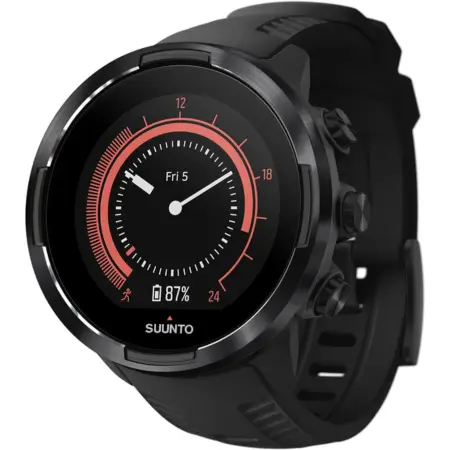
|
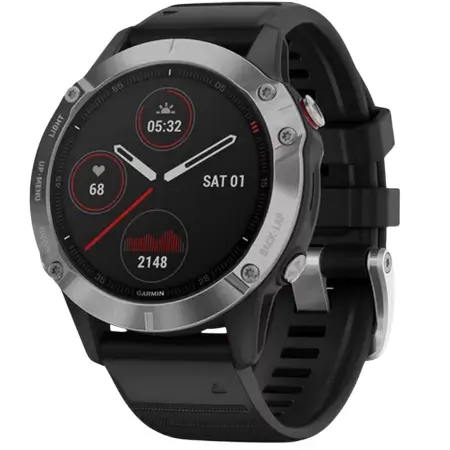
|
|
|---|---|---|
| Feature | Suunto 9 Baro | Garmin Fenix 6 |
| Design | Rugged, outdoor sports watch | Solid and robust design |
| Display | Touch Screen | 1.3-inch, 260 x 260 color memory-in-pixel |
| Intelligent Battery Modes | Yes | Power Manager for extended battery life |
| Glass Material | Sapphire Glass | Corning ® Gorilla ® Glass DX |
| Water Resistance | 100 M | 100 M |
| Heart Rate Monitoring | Wrist-based | Wrist-based, works underwater |
| Stress and Recovery | Yes | Recovery tools and abnormal heart rate alerts |
| Weather Functions | Yes | Yes |
| Sport Modes | Over 80 | 31 |
| GPS Tracking & Navigation | Yes | Fast and accurate GPS connectivity |
| Altimeter | Yes | Barometric altimeter |
| Connectivity | Compatible with Suunto App | Widgets, music storage, Garmin Pay |
| Special Features | FusedTrack™, Turn-by-turn navigation | Advanced training features, robust build |
| Price |
Pros & Cons
Suunto 9 Baro
Pros:- - Rugged and durable build quality.
- - Long battery life, ideal for endurance activities.
- - Reliable GPS and navigation features.
- - Touch screen interface on select models.
- - Limited software features.
- - Inaccurate heart rate monitoring.
Garmin Fenix 6
Pros:- - Wide variety of models for different users.
- - Advanced training and health features.
- - High-quality, legible display.
- - Highly customizable interface and features.
- - Complexity for beginners.
- - High cost for premium models.
Brand Comparison
When comparing Suunto vs Garmin, it's crucial to weigh their offerings against your specific needs as an athlete or outdoor enthusiast, considering factors such as build quality, battery life, and training features. Suunto's streamlined selection, with the robust award-winning sports watch Suunto 9, emphasizes durability and intuitive design. Garmin's lineup, including the feature-rich Garmin Fenix series, caters to a broader audience with its extensive range of models.
Delving into build quality, both brands showcase ruggedness with reinforced cases and durable lenses. However, the Garmin Fenix often feels more premium, with options like titanium bezels adding to its allure. In terms of battery life, the brand's innovations shine, particularly with models like the Enduro harnessing solar power to extend usage time.
Learn more about the options utilizing solar technology in our Best Solar Powered Watches article, with top picks for enhanced battery longevity.
The Suunto 9 Baro impresses with its intelligent battery modes, yet Garmin still edges out with options like the Fenix 6, which offers extensive battery longevity.
Training features are a battleground where Garmin Connect's ecosystem provides a comprehensive suite of analytics, from VO2 max to recovery advice. The Suunto app, while reliable, tends to offer a more basic approach. Ultimately, in the Suunto vs Garmin debate, your choice hinges on whether you prioritize Garmin extensive features or Suunto's focused, robust design.
Assessing Build Quality
While reflecting on the comprehensive features offered, it's essential to closely examine the build quality that sets these wearable devices apart in terms of durability and design. The Garmin Fenix series, particularly when compared to the Suunto Peak models, boasts an impressive construction. The Fenix's fiber-reinforced polymer case and use of Corning Gorilla Glass on some models underscore a commitment to durability that's hard to overlook. Similarly, Garmin Enduro's build quality is tailored to withstand the rigors of extreme sports, a testament to Garmin's focus on resilience in their higher-end models.
On the flip side, Suunto isn't a slouch in the build quality department either. Suunto Peak devices feature robust polyamide cases and, in some variants, sapphire crystal lenses that offer excellent scratch resistance. The choice between Suunto vs Garmin often boils down to personal preference, as both brands deliver highly durable wearables.
Battery Life
Diving into the crucial aspect of battery life, it's clear that both Garmin and Suunto watches offer impressive longevity, yet their performance varies significantly based on usage and specific model capabilities. Garmin Enduro, for instance, boasts a remarkably long battery life, enhanced by solar energy harvesting. It can endure indefinitely in certain modes, a testament to its battery power and the ingenuity behind its battery-saving technology.
Suunto's approach to battery management is equally noteworthy, especially with the Suunto 9 Baro. This model offers up to 170 hours of GPS tracking with its Tour battery saver mode. Such hours in GPS mode are made possible by intelligent battery modes that adapt power usage based on activity. The battery saving features extend the watch's use, ensuring you're unlikely to find yourself out of charge mid-adventure.
On the Garmin side, features like UltraTrac battery mode significantly extend the battery life of their devices, like the Fenix and Forerunner series. These modes tweak the GPS functionality to conserve power without drastically compromising accuracy, a balance that's crucial for endurance athletes and explorers alike.
Wearability
When examining wearability, I immediately noticed the design nuances that set both watch brands apart. Garmin variety in sizes, particularly with the Fenix 6 series, offers a more customized fit, which is a significant advantage for all-day comfort. Meanwhile, Suunto's robust build quality, exemplified by the tactile buttons of the Suunto 9, speaks to its durability, although its larger size can be a drawback for those with smaller wrists or a preference for a less obtrusive watch.
Design
Assessing the wearability, one must consider the design elements that impact comfort, aesthetics, and practical daily use. Both brands have honed the art of creating a watch that's both functional and visually appealing. Garmin watches often boast a more customizable interface, allowing users to tweak their new watch experience to their liking. The design of Suunto watches tends to be sleek, yet some models can feel a bit clunky on the wrist, especially during vigorous activities.
In terms of aesthetics, Garmin offers a variety of sizes and styles, ensuring there's a watch for every wrist. Suunto's design language is consistent, emphasizing robustness and durability, which can sometimes add bulk. Each brand has crafted its watches with a clear understanding of the wearer's needs, balancing ruggedness with everyday wearability.
Comfort
In evaluating the comfort, I've found that the straps and overall fit play pivotal roles in their day-to-day wearability. When I'm looking for the best running or hiking watch, I need something that won't chafe during long workouts or expeditions. Garmin brand's options, particularly their running watches, often feature hinged straps that conform nicely to the wrist, enhancing the heart rate sensor's accuracy. Meanwhile, Suunto's watches on the market provide a secure, albeit sometimes bulky, fit that can withstand rugged conditions. In the Garmin vs Suunto debate, both brands offer comfortable wearables, but the choice between a heart rate monitor that's unobtrusive or one built for endurance ultimately depends on personal preference and the intended use.
Smartwatch Capabilities
Smartwatch capabilities often serve as a decisive factor for consumers looking to integrate digital convenience with their active lifestyles, and both Garmin and Suunto deliver a range of features that cater to this demand. As I delve deeper into the functionalities, I'm impressed by how both brands leverage Bluetooth connectivity to ensure your smartwatch is a seamless extension of your phone. Notifications from your phone pop up on your wrist, allowing you to stay connected without constantly reaching for your device.
Garmin embraces a more comprehensive approach, with a highly customizable interface. Their companion app enables you to select and arrange widgets and data screens to your preference. This level of customization means I can tailor my Garmin smartwatch display to show the information I find most useful, whether I'm working out or in a meeting.
Suunto's smartwatches sync with their companion app, which is robust yet slightly less flexible. While you can't change data screens mid-workout, the Suunto app does a stellar job with post-workout analysis and setting up your preferences before you start.
In the end, it's the intricacies of these smartwatch capabilities that define the user experience for me. Both brands have honed their systems to enhance the active lifestyle, and it's the small details that can sway my decision.
Sensor Accuracy and Performance
When evaluating the performance of Garmin and Suunto wearables, the precision of their sensors is a critical factor that directly impacts the user's experience and the reliability of the data collected. Both brands are known for integrating cutting-edge technology into their devices, but there are nuances in their sensor accuracy and performance that deserve a closer look.
GPS accuracy is paramount for athletes and adventurers who rely on precise tracking. Garmin Fenix series is lauded for its reliable GPS functionality. Similarly, Suunto devices, particularly the Suunto 9 Baro, offer robust GPS performance paired with their famed barometric altimeter, which enhances elevation data accuracy.
Considering atmospheric pressure, both brands' barometers are instrumental in predicting weather changes, crucial for outdoor activities. The Suunto Baro line stands out with its FusedAlti technology, combining GPS and barometric data for refined altitude readings.
Optical heart rate sensors in both Garmin and Suunto watches deliver real-time heart rate data. While Garmin Elevate sensor is noted for its accuracy, Suunto has made significant strides with its proprietary sensor, particularly in capturing heart rate variability. This metric is essential for gauging training load and recovery.
Additionally, monitoring blood oxygen saturation has become a staple, especially at high altitudes. Here, Garmin Fenix series offers advanced blood oxygen monitoring, a feature that's also present in the Suunto 9, ensuring users have a comprehensive understanding of their physiological state during activities.
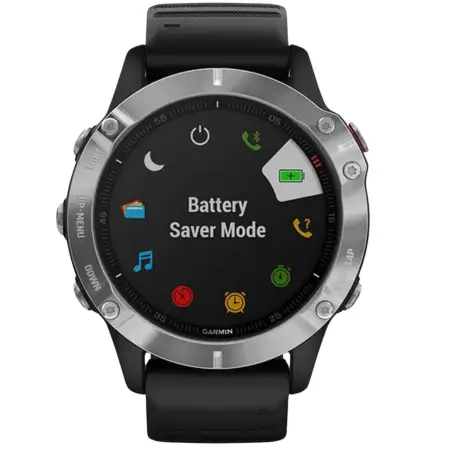
|
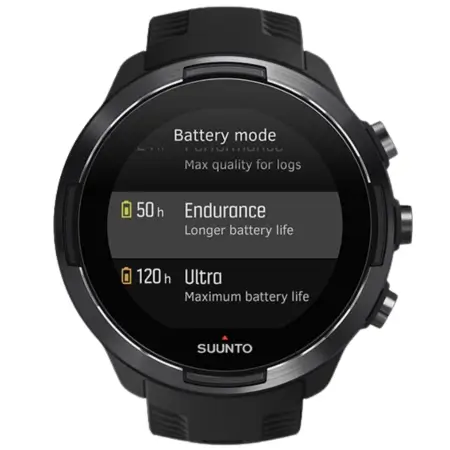
|
|
|---|---|---|
| Feature | Garmin Fenix 6 | Suunto 9 |
| Battery Life (Longest Mode) | Up to 28 days | Up to 120 hours |
| GPS Accuracy | Good, handles wooded areas well | Good, decent altimeter accuracy |
| Heart Rate Sensor | Reliable in all activities | Inaccurate during workouts |
| Screen Readability | High-contrast, better in sunlight | Less legible in low light |
| Customization | Highly customizable interface | Limited configuration options |
| Smartwatch Features | Extensive data (HR, stress, body battery) | Basic (HR, steps, sleep tracking) |
| Software Reliability | Responsive, automatic updates | Clunky navigation, slow response |
| Connectivity with Apps | Instantaneous, syncs with third-party apps | Flaky connection, limited app features |
| User Experience | User-centric, intuitive features | Lacks practicality in design choices |
Software and Customization
Garmin software and customization capabilities are expansive, allowing users to adapt their GPS watches thoroughly. I can tailor my training data screens with various metrics, switch sensor inputs, and even download custom apps and widgets through Garmin Connect IQ store. This level of personalization ensures that I can tweak my device to fit my workout needs precisely.
Suunto's approach is more streamlined, yet it still offers significant customization through its Suunto app. While I can't make changes directly on the watch during an activity, I can pre-configure the displays to show the metrics that matter most to me. Suunto's adaptive battery modes are unique, intelligently extending GPS tracking life during long activities—crucial for endurance athletes like me who need reliable data over extended periods.
Both brands support topographic mapping, but Garmin integration is more robust, with detailed color maps that can be a game-changer during off-trail adventures. Conversely, Suunto focuses on breadcrumb trails and altimeter data, which are essential for elevation-centric activities. Overall, both offer impressive customization options, but Garmin extensive software ecosystem might give it an edge for users seeking deep personalization.
Final Verdict
In the quest for the perfect adventure watch, it boils down to two options: Garmin and Suunto. Garmin stands out for its vast range of features and customization, ideal for tech-savvy athletes and adventurers who value versatility and personalization. Suunto, on the other hand, excels in durability and navigation, perfect for those seeking a robust and straightforward watch for challenging environments. Your choice depends on whether you prioritize simplicity and resilience with Suunto or technological sophistication with Garmin.
Interested in seeing how other brands compare to Garmin? Check out our comparison of the Coros Pace 2 vs Garmin Forerunner 55, for insights into how these models fare against each other.
Frequently Asked Questions
1. How do the Garmin Fenix 6 and Suunto 9 Peak compare in terms of GPS battery life?
The Garmin Fenix 6 and Suunto 9 Peak both higher-end models offer impressive GPS battery life, crucial for activities like trail running and cycling. The Fenix 6 boasts extended battery life, especially in models like the Garmin Fenix, while the Suunto 9 Peak is known for its accurate GPS signal retention and efficient power management.
2. What are the key differences between the Garmin Fenix 6 vs Suunto 9 in terms of triathlete training features?
For triathletes, both the Fenix and Suunto offer advanced features. The Fenix 6 provides detailed data like cadence, pulse ox, and stress levels, while Suunto 9 emphasizes accurate altitude readings and reliable HR monitoring. Both watches support different sports modes and are popular among triathletes for their robust tracking capabilities.
3. How does the Garmin Connect platform compare with Suunto's offers for tracking fitness data?
Garmin Connect and Suunto's platforms both allow users to track a variety of fitness data like step count, calories burned, and sleep patterns. Garmin Connect is known for its comprehensive ecosystem, integrating well with other Garmin products such as the Garmin Instinct and Fenix models. Suunto's platform, particularly with new Suunto models, focuses on detailed insights for activities and offers unique features for outdoor adventurers.
4. In terms of durability and design, how do the higher-end models like the Garmin Fenix 6 and Suunto 9 Peak stand out?
Both Garmin and Suunto's higher-end models, like the Fenix 6 and Suunto 9 Peak, are designed with durability in mind, catering to outdoor enthusiasts and trail runners. The Fenix 6 series, known for its rugged build, also includes features like a Pulse Ox tracker and an accelerometer. The Suunto 9 Peak stands out for its sleek design and accurate altitude measurements, making it a preferred choice for those who need precision in varying terrains.
5. Can I switch from a Fitbit to a Garmin or Suunto model without losing my data?
Switching from a Fitbit to a Garmin or Suunto model is a common scenario for those seeking more advanced features. While Fitbit offers basic functions and rate tracking, Garmin and Suunto's sports watches also provide more detailed insights. Users can often transfer some basic fitness data like step counts to their new device, but more specific metrics may not be directly transferable. It’s recommended to check compatibility and data transfer capabilities when moving to a new device, especially for those who already use their trackers extensively.
Share this:







